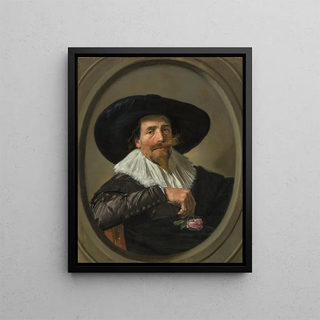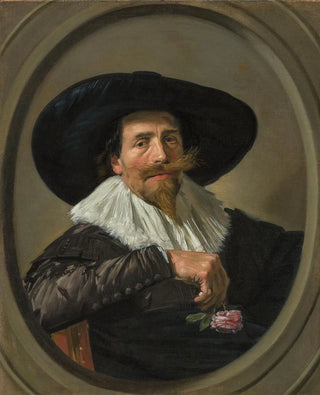Portrait Painting of Pieter Dircksz Tjarck - Frans Hals | Art print


View from behind

Frame (optional)
Pieter Dircksz Tjarck Art print by Frans Hals – Captivating introduction
The "Pieter Dircksz Tjarck" art print by Frans Hals is a work that transcends the simple frame of a pictorial representation. This canvas, created in the 17th century, immerses us in the fascinating world of Dutch portraits, where the personality of the subject is highlighted with rare intensity. Tjarck, a man from Haarlem's bourgeoisie, is captured in a posture that evokes both dignity and simplicity. Tjarck's frank and direct gaze seems to question the viewer, establishing a timeless dialogue between the work and its observer. This art print is much more than a mere image; it is a testimony of the era, a window into a society in full transformation.
Style and uniqueness of the work
Frans Hals's technical mastery is undeniable, and it manifests in every brushstroke of this art print. The light plays a crucial role, illuminating Tjarck's face while leaving certain areas in shadow, thus creating a striking depth. The details of the clothing, with their rich texture and natural rendering, testify to the artist's skill in capturing not only the physical appearance but also the very essence of his subject. The dark background, typical of Hals's portraits, enhances Tjarck's presence, placing him at the center of attention. This approach, both realistic and expressive, gives the work an almost living dimension, where the viewer can almost feel the energy of the depicted man. Hals succeeds in bringing his model to life, making this art print an emblematic work of his unique style.
The artist and his influence
Frans Hals, an iconic figure of the Dutch Golden Age, left a lasting mark on art history with his ability to capture the human soul. Born in Antwerp in 1582, he settled in Haarlem, where he developed a style characterized by its liveliness and expressiveness. Hals does not merely reproduce faces; he manages to convey emotions, to evoke personalities. His innovative approach influenced many artists, both contemporaries and successors, who saw in him a master of portrait art.

Matte finish

View from behind

Frame (optional)
Pieter Dircksz Tjarck Art print by Frans Hals – Captivating introduction
The "Pieter Dircksz Tjarck" art print by Frans Hals is a work that transcends the simple frame of a pictorial representation. This canvas, created in the 17th century, immerses us in the fascinating world of Dutch portraits, where the personality of the subject is highlighted with rare intensity. Tjarck, a man from Haarlem's bourgeoisie, is captured in a posture that evokes both dignity and simplicity. Tjarck's frank and direct gaze seems to question the viewer, establishing a timeless dialogue between the work and its observer. This art print is much more than a mere image; it is a testimony of the era, a window into a society in full transformation.
Style and uniqueness of the work
Frans Hals's technical mastery is undeniable, and it manifests in every brushstroke of this art print. The light plays a crucial role, illuminating Tjarck's face while leaving certain areas in shadow, thus creating a striking depth. The details of the clothing, with their rich texture and natural rendering, testify to the artist's skill in capturing not only the physical appearance but also the very essence of his subject. The dark background, typical of Hals's portraits, enhances Tjarck's presence, placing him at the center of attention. This approach, both realistic and expressive, gives the work an almost living dimension, where the viewer can almost feel the energy of the depicted man. Hals succeeds in bringing his model to life, making this art print an emblematic work of his unique style.
The artist and his influence
Frans Hals, an iconic figure of the Dutch Golden Age, left a lasting mark on art history with his ability to capture the human soul. Born in Antwerp in 1582, he settled in Haarlem, where he developed a style characterized by its liveliness and expressiveness. Hals does not merely reproduce faces; he manages to convey emotions, to evoke personalities. His innovative approach influenced many artists, both contemporaries and successors, who saw in him a master of portrait art.
12,34 €






